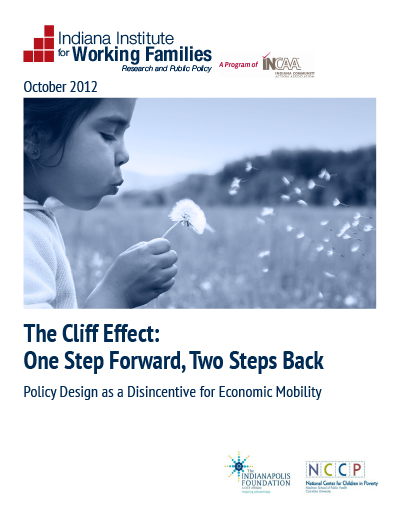The Cliff Effect: One Step Forward, Two Steps Back
 2020 UPDATE: Indiana Family and Social Services Administration has mitigated the child care cliff through a sliding scale copay structure for CCDF vouchers. 2020 UPDATE: Indiana Family and Social Services Administration has mitigated the child care cliff through a sliding scale copay structure for CCDF vouchers.
One of the greatest barriers to self-sufficiency for low-income individuals is the “cliff effect.” Eligibility for work support programs such as Supplemental Nutrition Assistance Program (SNAP), and Child Care Development Fund (CCDF) are based on income. Generally, eligibility for these programs is below 200% of the Federal Poverty Guidelines, with benefits phasing out as earnings increase. The unintended consequence of this design leads to a disincentive towards economic mobility, or results to a situation in which the parent or guardian is working harder, but is financially worse off.
Legislative Activity
Testimony Before the Senate Committee on Family and Children Services
Support Testimony for SB 549, Removal of asset limits for SNAP food assistance program
Presented by Derek Thomas, Senior Policy Analyst, February 16, 2015
Testimony Before the Senate Committee on Family and Children Services
In Support of SB 129, Eligibility for child care voucher
Presented by Derek Thomas, Senior Policy Analyst, February 9, 2015
Testimony Before the House Committee on Family, Children and Human Services
In Support of HB 1616, Eligibility for child care voucher
Presented by Derek Thomas, Senior Policy Analyst, January 28, 2015
Testimony Before the House Committee on Family, Children and Human Services
Presented by Derek Thomas, Senior Policy Analyst, January 28, 2014
Cliff Effect Resources
Cliff Effect News
-
Journal Gazette (Fort Wayne, Ind.), 4/9/2015
Family Friendly: Chid-care assistance can still pass Senate
-
The StatehouseFile.com, 3/17/2015
Low-income families could keep child care help longer under bill moving in Senate
-
WCLJ TV 42, 3/13/2015
Joy in Our Town, with guest Derek Thomas, senior policy analyst with IIWF
-
The Journal Gazette (Fort Wayne), 02/20/2015
Family Friendly: House bill strengthens bridge to self-sufficiency
-
The Journal Courier (Lafayette, Ind.) 2/19/2015
Bill to expand SNAP eligibility dies in committee
-
TheStatehouseFile.com (Franklin, Ind.), 02/17/2015
Bill to help low-income Hoosiers with child care moves to Senate
-
TheStatehouseFile.com (Franklin, Ind.), 02/17/2015
No vote on bill to eliminate asset test for food help
-
TheStatehouseFile.com (Franklin, Ind.), 02/09/2015
Lawmakers hear concerns about 'cliff' effect for child care program
-
The Guardian U.S. - 7/20/2014
The Benefits Cliff - When Minimum Wage Increases Backfire on the People in Need
-
Salem Leader 02/13/14
More Indiana working mothers are low-income
-
kpcNEWS.com 1/26/14
Focus On Efforts That Help Families Transition Off Welfare
-
Joy in Our Town 12/20/13
Interview with Program Manager Jessica Fraser on the Institute's Cliff Effect Research
-
IBJ 1/19/2013
Advocacy group waging war against welfare 'cliff effect
-
Reuters.com 12/20/2012
The Unequal State of America – A Hoosier falls off the benefit cliff
-
CarrierJournal.com 11/25/2012
Advocates look at how poor are pushed over Indiana's benefits cliff
-
IndyStar.com 11/15/2012
My View: Indiana policies hurt middle-class growth
-
WBEZ 10/26/2012
Front and Center profile story on Cliff Effect
|

 2020 UPDATE: Indiana Family and Social Services Administration has mitigated the child care cliff through a
2020 UPDATE: Indiana Family and Social Services Administration has mitigated the child care cliff through a